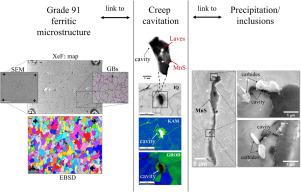91级铁素体钢蠕变空化机理研究
IF 2.9
Q2 MATERIALS SCIENCE, MULTIDISCIPLINARY
引用次数: 0
摘要
用于高温应用(如发电厂)的91级钢部件的大多数过早失效归因于蠕变空腔成核。本研究通过4%和10%应变下的中断蠕变试验,研究了铁素体P91服役材料在早期形成阶段的蠕变空洞形核,以及在后期阶段通过分析失效应变为35.6%的失效蠕变试验样品。虽然高温暴露下的空腔生长不需要施加应力,但在高应力区域,空腔的相互联系更为明显。研究发现,在蠕变早期,硫化锰(MnS)包裹体极易受到损伤,并负责第一个空腔的形核。M23C6碳化物和位于MnS夹杂物与铁素体基体界面的Laves相的存在促进了这一过程的发生。晶界取向错误与空化高度相关,45−55°取向错误的晶界是铁素体微观结构中的主要类型,因此最常发生空化。虽然在微观结构中出现的频率较低,但在15−20°取向错误的小角gb中空化率最高。局部变形被发现与空化密切相关,而施密德因子与损伤没有统计学上的显著联系。在蠕变早期,通过TEM和SEM成像观察到密集的位错结构,在破坏阶段明显减少,这可能是由于在空洞形成和裂纹扩展过程中位错的释放。本文章由计算机程序翻译,如有差异,请以英文原文为准。

Investigation of creep cavitation mechanisms in ferritic Grade 91 steel
The majority of premature failures in Grade 91 steel components used in high-temperature applications, such as power plants, are attributed to creep cavity nucleation. This study examined creep cavity nucleation in ferritic P91 ex-service material during its early formation stages through interrupted creep tests at 4% and 10% strain, as well as in later stages by analysing a failed creep-tested specimen with 35.6% strain at failure. While cavity growth under high-temperature exposure did not require applied stress, cavity interlinkage was more pronounced in high-stress regions. It was found that manganese sulfide (MnS) inclusions were highly prone to damage and were responsible for the nucleation of the first cavities during early creep life stages. This process was facilitated by the presence of M23C6 carbides and Laves phase located at the interface between the MnS inclusions and the ferrite matrix. Grain boundary misorientation was highly associated with cavitation with grain boundaries of misorientations being the predominant type in the ferritic microstructure and, consequently, the most frequently cavitating. Although less frequent in the microstructure, lower-angle GBs with misorientations exhibited the highest cavitation ratios. Localized deformation was found to be strongly correlated with cavitation, whereas the Schmid factor did not exhibit a statistically significant link to damage. A dense dislocation structure, observed using TEM and SEM imaging at early creep life stages, was significantly reduced at the failure stage, likely due to dislocation relief during cavity formation and crack propagation.
求助全文
通过发布文献求助,成功后即可免费获取论文全文。
去求助
来源期刊

Materialia
MATERIALS SCIENCE, MULTIDISCIPLINARY-
CiteScore
6.40
自引率
2.90%
发文量
345
审稿时长
36 days
期刊介绍:
Materialia is a multidisciplinary journal of materials science and engineering that publishes original peer-reviewed research articles. Articles in Materialia advance the understanding of the relationship between processing, structure, property, and function of materials.
Materialia publishes full-length research articles, review articles, and letters (short communications). In addition to receiving direct submissions, Materialia also accepts transfers from Acta Materialia, Inc. partner journals. Materialia offers authors the choice to publish on an open access model (with author fee), or on a subscription model (with no author fee).
 求助内容:
求助内容: 应助结果提醒方式:
应助结果提醒方式:


